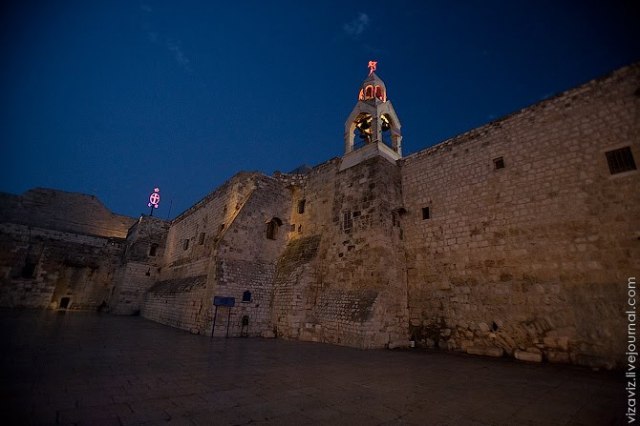Left: Christ in the manger; Right: the Empty Tomb
No description of the Nativity Icon would be complete without mention of Jesus’ appearance in the manger.
It should be never forgotten that Jesus came to us in order to die – this was known by Him, at least, from the very beginning. Therefore, in Iconography, the manger in the Nativity Icon deliberately resembles a stone coffin, the swaddling clothes resemble a burial shroud, and the cave itself can even be said to prefigure Christ’s tomb.
With the side-by-side comparison shown above of the Icon of the Nativity with the Icon showing the Myrrh-bearing women discovering Jesus’ empty tomb, no more words are necessary. (1)
The Passion of Nativity
… Let us look more closely at the child in the relief. “His tight swaddling clothes are evocative of burial wrappings. In the byzantine tradition, there is an intentional connection between the swaddling clothes of the infant in a Nativity icon and the burial clothes of the Epitaphios (epi– upon; taphos- grave or tomb) icon which is venerated and anointed during Great Friday Vespers. Also on Great Friday, the “soma” icon on the crucifix is taken down from the cross and shrouded in identical wrappings before it is processed and reposed in the sanctuary.”

“…Note, as well, that the “manger” is a cave, a small hollow in a rock formation that mirrors Jesus’ tomb in the gospels. In many icons, Jesus’ cradle is a stone box. Who would lay a child in a coffin? What macabre motive would make an artist paint a baby as a mummy and give him a tomb as his nursery? Indeed, the motive is not macabre, but joyful and eschatologically triumphant: we only understand the significance of the incarnation if we hold it in tension with Jesus’ saving death; we may not separate the two. This also reminds us that the liturgical year commemorates events in the life of Jesus but it never parses the paschal mystery.”

Basilica of the Nativity in Bethlehem
The Church of the Nativity in Bethlehem is one of the oldest continuously operating churches in the world, and the oldest in the Holy Land (founded in 325)

A virgin womb, conceiving thee, revealed thee;
a virgin tomb, receiving thee, concealed thee.
We glorify her from whom thou didst receive a beginning in time,
and we honour him that ministered to the end of thine earthly life for our sakes,
asking that through their prayers, O merciful Saviour,
we might be deemed worthy of thy Kingdom of the Heavens.
Theotokion on the Praises for the Feast of St. Joseph of Arimathea
Appendix to the July Menaion, Holy Transfiguration Monastery

Church Of The Nativity Bethlehem Stable
All the eschatological themes of the Advent season converge in the Nativity tableau and are carried forward into Christmas. This should not surprise us. The birth of Christ and his salvific death form the cosmic fulcrum upon which the beam of human history rests, with creation and eschaton at each end. In a nativity icon this is super concentrated. Incarnation and eschaton are so ingeniously and inextricably intertwined that we might not even read “passion” in what is written in the icon unless we understand the symbolic significance of the iconographic elements. The best known example of this is the gifts of the wise men: while gold and frankincense represent Jesus’ kingship and priesthood, respectively, myrrh, used for embalming, is a symbol of his death.

When I look at a Nativity icon and I see a child embraced by death, and embracing death, I have at least an inkling of what Rilke was, perhaps, trying to convey in the first Duino Elegy:
“For beauty is nothing but the beginning of terror, which we are still just able to endure, and we are so awed because it serenely disdains to annihilate us.” (2)
(2) Posted at https://memoriadei.wordpress.com/2010/12/17/the-ox-the-ass-and-the-passion-of-the-nativity/


